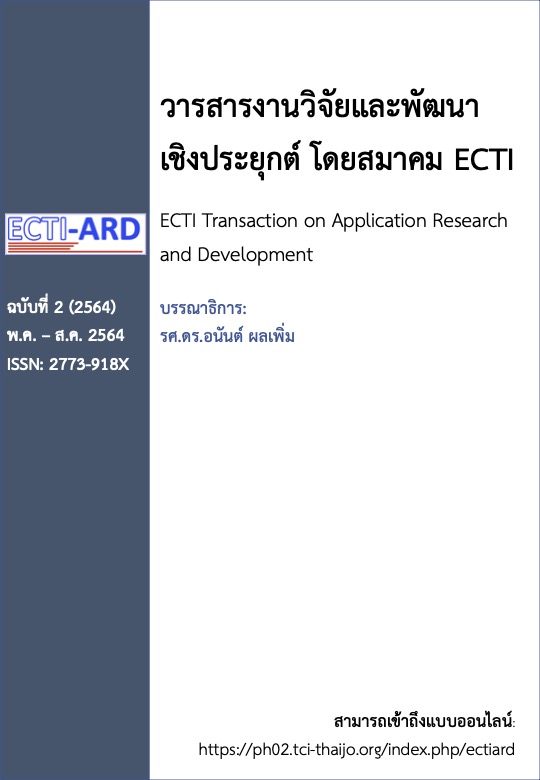การพัฒนาโปรแกรมที่สัมผัสและรู้สึกได้ด้วยรหัสคิวอาร์โค้ดเพื่อควบคุมหุ่นยนต์ สำหรับนักเรียนระดับประถมศึกษา
Main Article Content
บทคัดย่อ
การสอนให้เด็กเกิดการเรียนรู้การโค้ดดิ้งเป็นสิ่งที่สำคัญมากในปัจจุบันสำหรับเด็กในระดับประถมศึกษา การที่จะสอนให้เขียนโปรแกรมด้วยคอมพิวเตอร์หรือแท็บเล็ต ค่อนข้างจะยากและอาจจะเกินวัยสำหรับเด็กทั่ว ๆ ไป การที่จะให้เด็กเขียนโปรแกรมโดยไม่ใช้คอมพิวเตอร์จำเป็นจะต้องนำโปรแกรมที่เขียนออกมาเขียนนอกจอคอมพิวเตอร์ ไม่ต้องใช้เมาส์หรือคีย์บอร์ดในการเขียนโปรแกรม โปรแกรมที่สัมผัสและรู้สึกได้ด้วยรหัสคิวอาร์โค้ดได้พัฒนาขึ้นมาเพื่อให้เด็กในระดับประถมศึกษาได้เขียนโปรแกรมควบคุมหุ่นยนต์ โดยใช้เทคโนโลยีคิวอาร์โค้ดในการกำหนดรหัสคำสั่งในการควบคุมหุ่นยนต์ ผลการวิจัยพบว่า โปรแกรมที่สัมผัสและรู้สึกได้โดยการกำหนดรหัสคำสั่งด้วยคิวอาร์โค้ด ทำให้เด็กสามารถเรียนรู้และโปรแกรมหุ่นยนต์ได้โดยไม่ต้องเขียนโปรแกรมบนคอมพิวเตอร์ การส่งรหัสคำสั่งด้วยคิวอาร์โค้ดสามารถทำงานได้โดยไม่มีข้อผิดพลาด เด็กเกิดการเรียนรู้การเขียนโปรแกรมใน 2 รูปแบบคือ 1) คำสั่งแบบลำดับ และ 2) คำสั่งวนซ้ำ
Article Details
เอกสารอ้างอิง
H.Suzuki, and H.Kato, AlgoBlock: a tangible programming language, tool for collaborative learning. in Proceedings of the 4th European Logo conference (Eurologo’93) Athens Greece,1993.
P.Frei,V.Su,B.Mikhak,And H.Ishii, Curlybot: designing a new class of computational toys. in proceedings of the SIGCHI conference on Human factors in computing systems,2000.
P.Wyeth & G.Wyeth, ElectronicBlocks: Tangible Programming Elements for Preschoolers,2003.
S. Raffle, Topobo: A 3-D Constructive Assembly System with Kinetic Memory. M. S. Thesis, Massachusetts Institute of Technology ,2004.
O.Zukerman, System Block: Learning about Systems Concepts through Hands-onModeling and Simulation. M.S. Thesis, Massachusetts Institute of Technology,2004.
A. Sipitakiat and N. Nusen, Robo-Blocks: designing debugging abilities in a tangible programming system for early primary school children. in: Proceedings of the 11th International Conference on Interaction Design and Children, ACM, pp. 98-105,2012.
O.Zuckerman, Flowness + FlowBlocksUncovering the Dynamics of Everyday Life through Playful Modeling. Cambridge, MA: MIT Media Arts and Sciences Doctoral Dissertation,2007.
Ullmer, B. Tangible Interfaces for Manipulating Aggregates of Digital Information. Cambridge,MA: MIT Media Arts and Sciences Doctoral Dissertation,2002.
J.Patten, H. Ishii, J. Hines and G. Pangaro, Sensetable: A wireless Object Tracking Platform for Tangible User Interfaces. in Proceedings of Conference on Human Factors in Computing Systems (CHI ‘01), ACM Press, 252-260, 2001.
B. Ullmer and H. Ishii, Emerging frameworks for tangible user interfaces. IBM Systems Journal 393: 915–31, 2000.
H.Ishii, & B.Ullmer, Tangible Bits: Towards Seamless Interfaces between People Bit and Atoms. In Proceedings of CHI’97,1997.
Electronics-tutorials.ws, https://www.electronics-tutorials.ws/systems /open-loop-system.html
Electronics-tutorials.ws, https://www.electronics-tutorials.ws/systems /closed-loop-system.html
Papert, S, Mindstorms:children, computer, and powerful ideas. New York: Basic Books,1980.
M. Resnick and B. Silverman, Some reflections on designing construction kits for kids, in Proceedings of the 2005 conference on Interaction design and children, IDC ’05, (New York, NY, USA), pp. 117–122, ACM, 2005.
MIT APP INVENTOR, https://appinventor.mit.edu


